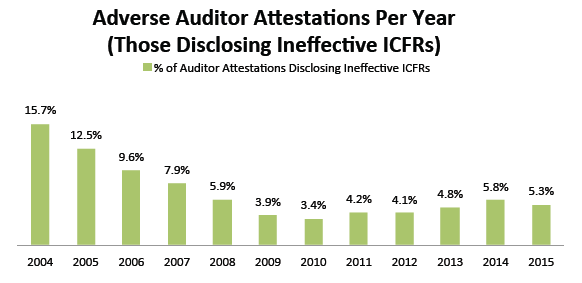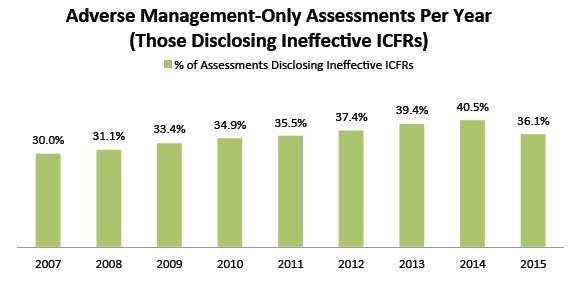A fundamental tenet of financial reporting is that a company’s internal controls over financial reporting (ICFR) are sufficiently robust to ensure transactions are properly recognized and disclosed in its financial statements. The appropriateness of financial statements hinges on the fair presentation in conformity with GAAP. Furthermore, the concept of materiality is the deciding factor of what is “fair” and what is not.
However, at times companies misstate their financial statements. In some situations these misstatements are simple, unintentional errors; whereas, in other cases they may be intentional. When misstatements occur, companies must determine whether or not these misstatements result in materially misleading financial statements. For purposes of clarity, an error is defined in ASC 250, Accounting Changes and Error Corrections as “[a]n error in recognition, measurement, presentation, or disclosure in financial statements resulting from mathematical mistakes, mistakes in the application of [GAAP], or oversight or misuse of facts that existed at the time the financial statements were prepared.”
Because identified misstatements that relate to the current period can be addressed by management without any required restatements, today’s post will address certain risk areas and requirements that companies will want to address in assessing misstatements in prior periods.
Materiality
In a previous post I wrote about materiality considerations, which should be considered in assessing whether or not the prior period financial statements are materially misstated. Indeed, it is well established that calculating a quantitative threshold of materiality is an important step in a materiality assessment (such as 5-10% of pre-tax income). However, companies should give consideration to qualitative factors as well. The SEC’s staff issued SAB No. 99 to provide some guidance to considering qualitative factors. Notwithstanding its guidance, SAB No. 99 does not address what might be considered not material.
Types of restatement
Depending on the outcome of a materiality assessment, companies may find themselves in one of two categories:
- Reissuance restatement – referred to as “Big R” restatement because this means the previously issued financial statements were materially incorrect and, therefore, are unreliable and must be reissued/restated. In these cases, the prior period financial statements must be amended.
- Revision restatement – referred to as “Little r” restatement because, although there are errors in the previously issued financial statements, they were not material to the prior periods. A company may choose to either make the error correction in the current period or it may recast its prior period financial results in connection with issuing its current period financial statements. When a company elects to recast its prior period financial statements in connection with issuing its current period financial statements, it revises its financial statements. In these circumstances, the prior period financial statements do not need to be amended.
Sarbanes-Oxley Act certification requirements
In the context of restatements, SEC registrants must be aware of risk exposure related to Sarbanes-Oxley Act (SOX) certification requirements. As a refresher, as early as 2004 SEC registrants were required to implement certain provisions of SOX. These provisions address requirements that the principal executive officer or officers (CEO or equivalent) and the principal financial officer or officers (CFO or equivalent) must certify. The first requirement, Section 302, is found in SOX’s Title III – Corporate Responsibility. The second requirement, Section 906, is found in SOX’s Title IX – White-Collar Crime Penalty Enhancements.
- SOX Section 302 – In connection with filing of periodic financial reports with the SEC, the CEO and CFO (as signing officers) are required to certify in each quarterly and annual report:
- the signing officer has reviewed the report;
- based on the signing officer’s knowledge, the report doesn’t contain any untrue statement of a material fact or omit to state a material fact necessary in order to make the statements made, in light of the circumstances under which such statements were made, not misleading;
- based on the signing officer’s knowledge, the financial statements, and other financial information included in the report, fairly present in all material respects the financial condition and results of operations of the issuer as of, and for, the periods presented in the report;
- the signing officers:
- are responsible for establishing and maintaining internal controls
- have designed such internal controls to ensure that material information relating to the issuer and its consolidated subsidiaries is made known to such officers by others within those entities, particularly during the period in which the periodic reports are being prepared;
- have evaluated the effectiveness of the issuer’s internal controls as of a date within 90 days prior to the report; and
- have presented in the report their conclusions about the effectiveness of their internal controls based on their evaluation as of that date;
- the signing officers have disclosed to the issuer’s auditors and the audit committee of the board of directors (or persons fulfilling the equivalent function):
- all significant deficiencies in the design or operation of internal controls which could adversely affect the issuer’s ability to record, process, summarize, and report financial data and have identified for the issuer’s auditors any material weaknesses in internal controls; and
- any fraud, whether or not material, that involves management or other employees who have a significant role in the issuer’s internal controls; and
- the signing officers have indicated in the report whether or not there were significant changes in internal controls or in other factors that could significantly affect internal controls subsequent to the date of their evaluation, including any corrective actions with regard to significant deficiencies and material weaknesses.
- SOX Section 906 – In connection with filing of periodic financial reports with the SEC, the CEO and CFO (as signing officers) are required to certify in each quarterly and annual report:
- the periodic financial report containing the financial statements fully complies with the requirements of section 13(a) or 15(d) of the Securities Exchange Act of 1934 and that information contained in the periodic report fairly presents, in all material respects, the financial condition and results of operations of the issuer.
Section 906 provides for criminal penalties if the CEO and/or CFO:
- certifies any statement within Section 906 knowing that the periodic report accompanying the statement does not comport with all the requirements set forth in Section 906 shall be fined not more than $1,000,000 or imprisoned not more than 10 years, or both; or
- willfully certifies any statement as set forth in Section 906 knowing that the periodic report accompanying the statement does not comport with all the requirements set forth in Section 906 shall be fined not more than $5,000,000, or imprisoned not more than 20 years, or both.
In light of these certification requirements and the potential criminal penalties, signing officers must be confident that their financial reporting controls are reliable. With this in mind, when Big R restatement risk is heightened, companies should be cognizant of the regulatory and legal exposure associated with potential non-compliance.
Furthermore, when it comes to material misstatements in the company’s prior period financial statements, there is a rebuttable presumption that a material weakness in ICFR exists. Another thing to keep in mind is that even though a Little r restatement may end up being the correct solution to addressing misstatements, the SEC registrant may end up concluding that a material weakness still exists in ICFR. This gets at the concept of the “could” factor in assessing deficiencies in ICFR, which I previously wrote about.
Tips for companies
I recently listened to a webcast discussing 10 pitfalls to avoid when navigating a Big R restatement (replay link). For convenience, I’ve listed these 10 pitfalls:
- Engaging inexperienced counsel and advisors for the investigation
- Forming a special committee when the audit committee might suffice
- The run-away or open-ended investigation
- Failing to keep auditors apprised of the investigation and errors found
- Indecisiveness and inability to reach conclusions
- Waiting too long to deal with wrongdoers
- Not self-reporting findings to the SEC
- Audit committee micromanagement of the restatement
- Failing to remediate
- Creating an unnecessarily detailed SAB 99 materiality analysis
In addition to these tips, companies should ensure they follow the standards governing accounting restatements in ASC 250 and that they assess misstatements for each reporting period. Although certain misstatements may be insignificant in any given reporting period, they could aggregate to a material amount over time (such as the impact to the balance sheet).
When restatements arise, SEC registrants will need to disclose relevant information on SEC Forms 10-K/A and 8-K (for Big R) and SEC Form 10-K (for Little r).
Influencing the narrative
I’m going to fast forward the process of restating financial statements to communicating with outsiders what the facts are. When management becomes aware of material misstatements in prior periods, the company should be clear and assertive with users of its financial statements about the nature and extent of the misstatements identified. In connection with its assessment, management should be able to, at a minimum, address the following concerns:
- explain the magnitude of the misstatement;
- identify which accounts were affected;
- describe what was done to remediate the misstatement (both in the financial statements and in ICFR);
- explain what programs and controls have been put in place to avoid misstatements from occurring in the future; and
- explain the implications of misstatements on the company’s future financial reporting and forecasts
It goes without saying that if companies do not take active measures to effectively management the risks I’ve discussed, users of their financial statements may call into question whether or not the root-causes in the company have been addressed.






